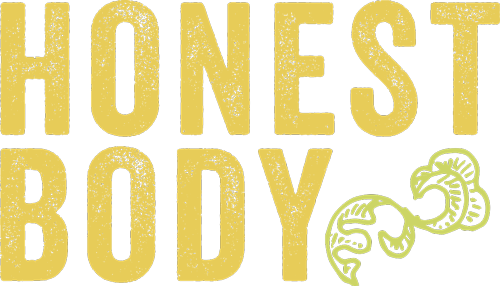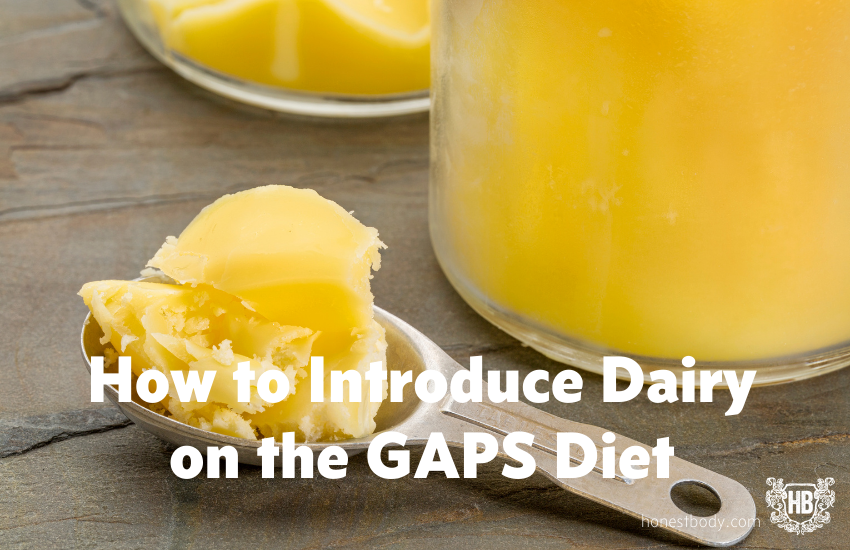How to Introduce Dairy on the GAPS Diet
If you have difficulty with dairy, you are not alone. Many people come to the GAPS Diet with numerous intolerances and food reactions, and dairy is a common one. Avoiding foods that cause reactions is a good idea, for a time. By the time some people find GAPS, their diet is so restricted that they are wondering what in the world they can eat. But what if you could support your body to heal the digestive tract north to south, improve absorption of nutrients, and get rid of many of your food intolerances to boot? That is exactly what the GAPS Diet Introduction Stages are designed to do. This post is for those who are doing or planning to do the GAPS diet and wondering how to introduce dairy on GAPS. For more about the GAPS diet, see my post here.
How do I know if I have a Problem with Dairy?
There are several ways you can know if you have a problem with dairy products:
- Experience. Many people have obvious reactions when they eat dairy.
- Lab testing. For food sensitivities, some tests are better than others. In my practice, I utilize targeted testing to help you remove foods that cause inflammation and reintroduce them when your gut has healed.
- The home skin patch sensitivity test. Place a small amount of the food, in the form you intend to introduce it, on the inside of the wrist at bedtime. When you wake up, check the spot. If it is irritated, red, or itchy, wait another few weeks on GAPS before attempting the test again. Once there is no reaction on the skin, you can try introducing the food.
- Note on anaphylactic allergies: Please do NOT attempt to introduce foods to which you have an anaphylactic reaction.
Why Should I try to Introduce Dairy?
Though dairy is a real problem for many people, dairy products also have a lot of benefits to offer the GAPS person’s gut.
- Butterfat from pastured animals is a good source of fat-soluble vitamins such as A, D, and K (vitamin K can be especially beneficial from raw cream and butter).
- Cultured dairy contains lactic acid, which is healing and soothing for the gut lining, as well as good bacteria and/or yeast which can support the rebalancing of the gut microbiome.
- The fermentation process for GAPS is recommended to last at least 24-hours, which converts the majority of lactose into lactic acid. It also breaks down proteins and immunoglobulins, making it a much more digestible food for those with a damaged gut.
- Whole milk yogurt or kefir from grass-fed animals can do wonders for an irritated gut lining and give relief from diarrhea and loose stools.
- Alternatively, homemade sour cream and ghee can be beneficial for those struggling with constipation.
Another reason to introduce dairy? GAPS Strawberry Ice Cream! Can’t do dairy yet? Try this simple custard.
How do I Introduce Dairy on GAPS Intro Diet?
If you have no reaction to the sensitivity test, and no known anaphylactic allergy, you are ready to try introducing dairy. How you introduce it depends on your individual situation. Here are some scenarios.
You are starting with the GAPS Introduction Diet, and you have no known issues with dairy:
- Start with homemade, 24-hr cultured yogurt or sour cream (the same recipe, just use cream rather than milk) from the beginning – Stage 1.
- Once that is well-tolerated, you can try kefir (this is a more potent probiotic so add it in slowly). Add kefir anytime during Intro, depending on how the probiotics are tolerated.
- Add ghee – Stage 2.
- If ghee is well-tolerated, you can add butter – Dr. Natasha does not have a specific stage for this, but once the ghee is tolerated, butter can be introduced.
- Try a mouthful of aged, high-quality cheddar cheese – Full GAPS.
- Other cheeses that are allowed on Full GAPS: Asiago, Blue, Brick, Brie, Camembert, Cheddar, Colby, Edam, Gorgonzola, Gouda, Havarti, Limburger, Monterey Jack, Muenster, Parmesan, Port du Salut, Roquefort, Stilton, Swiss, Romano, un-creamed cottage cheese (dry curd). If any reaction occurs, try a different cheese after the reaction has settled down.
You are starting with the GAPS Introduction Diet, and you have a sensitivity to dairy:
- During Stage 1 avoid dairy.
- Do a sensitivity test before introducing each dairy item, starting with homemade ghee. If you have a reaction to ghee, continue on with the Introduction Diet Stages without introducing dairy products for about 6 weeks. Then try the sensitivity test again.
- If no reaction to the test, try ghee – Stage 2 and on.
- After 6 weeks on the GAPS diet, try butter (Stage depends on how quickly you progressed through GAPS Intro).
- If the butter is tolerated, then in 6-12 weeks’ time try gradually introducing homemade 24-hr yogurt made with whole milk or cream. Start with 1 tsp per day and gradually increase the amount. If any negative reaction occurs, wait for 4 weeks and try again.
- Once the yogurt is tolerated, try introducing homemade 24-hr kefir made from whole milk or cream. Start with 1 tsp per day and gradually increase the amount, since kefir is a potent probiotic.
- Try a mouthful of aged, high-quality cheddar cheese – Full GAPS.
- Other cheeses that are allowed on Full GAPS: Asiago, Blue, Brick, Brie, Camembert, Cheddar, Colby, Edam, Gorgonzola, Gouda, Havarti, Limburger, Monterey Jack, Muenster, Parmesan, Port du Salut, Roquefort, Stilton, Swiss, Romano, un-creamed cottage cheese (dry curd). If any reaction occurs, try a different cheese after the reaction has settled down.
What if I am Starting with the Full GAPS Diet?
If you are starting with the Full GAPS Diet, follow the Dairy Introduction Protocol (DIP), whether you have a known sensitivity to dairy or not (remember, we are not talking about anaphylactic allergies here).
Dairy Introduction Protocol
Do a sensitivity test before introducing each item in the following order:
- Homemade ghee. If tolerated keep on with just ghee for about 6 weeks. If it is not tolerated, you may try the DIP again after a few months on GAPS.
- Butter. If tolerated keep on with ghee and butter for about 6-12 weeks. If it is not tolerated, wait 4 weeks and try again, perhaps with a higher quality butter or cultured butter.
- Homemade 24-hr yogurt made with whole milk or cream. Start with 1 tsp per day and gradually increase the amount. If any negative reaction occurs with any of the following steps, wait for 4 weeks and try again.
- Homemade 24-hr kefir made from whole milk or cream. Start with 1 tsp per day and gradually increase the amount, since kefir is a potent probiotic.
- High-quality cheddar cheese – try one mouthful and see if there are any reactions.
- Other cheeses that are allowed on Full GAPS: Asiago, Blue, Brick, Brie, Camembert, Cheddar, Colby, Edam, Gorgonzola, Gouda, Havarti, Limburger, Monterey Jack, Muenster, Parmesan, Port du Salut, Roquefort, Stilton, Swiss, Romano, un-creamed cottage cheese (dry curd). If any reaction occurs, wait a few weeks, then try a different cheese, or a higher quality cheese.
Important Notes about Dairy
- Dairy quality is so important. If you are not tolerating dairy, it may be related to the quality of the dairy products. Products made at home with raw milk from heritage breed cows on pasture are often tolerated when commercial dairy (even commercial USDA Organic) is not. Depending on how sensitive an individual is, commercial pastured products such as Kerrygold may be okay when there is no better option available.
- High-protein dairy (yogurt and kefir) can be helpful in cases of diarrhea, causing stools to firm up. However, in cases of constipation, consume only high-fat dairy such as butter and cultured cream.
This is a basic outline of the different ways to introduce dairy on GAPS. Every ‘body’ is different, and yours may need individualized support. If you feel you need more, including functional lab testing and individualized recommendations, book a free GAPS Inquiry Call. I take a further individualized approach with one-to-one clients, based on my food sensitivity testing of choice.
Often if folks have been on GAPS for a while and are not seeing the results they want, working with an experienced GAPS Practitioner can help.
Have experiences or questions about GAPS and dairy that you want to share? Please leave a comment!



4 thoughts on “How to Introduce Dairy on the GAPS Diet”
Hello!
My husband was recently diagnosed with celiac disease, he’s been off gluten for about 9 months with definite improvement but still suffers from fatigue, brain fog, dizziness (more like eye strain), and occasional digestive upset. So we are working our way backwards into the gaps diet to hopefully help him get back to normal. We are just about ready to start stage 1 of intro but I’m wondering if he needs to stop drinking raw milk (a huge part of our regular diet), he doesn’t have any known issues with dairy. Is it necessary to stop drinking quality raw milk during intro? Thank you for any advice, your website is amazingly informative, we appreciate your hard work!
Hi Hanna,
Thank you for your kind words about the website. We’re so glad that it’s helpful!
Dr. Natasha does recommend only dairy which has been fermented a minimum of 24-hrs, and ghee and butter, if tolerated. Even though raw milk is an amazing and very nutritious traditional food, it still contains lactose and casein, which can be a problem for GAPS people. When it is fermented for 24 hours, the lactose gets completely digested by the culture and converted to lactic acid which is actually soothing for an inflamed gut. The casein also undergoes some alteration which often makes it more tolerable for GAPS people. Lactose feeds pathogenic as well as beneficial microbes. When not properly digested by beneficial bacteria in a healthy gut, it gets through leaky gut junctions and causes problems for many people.
Your husband, if he has no issue with dairy, will likely be able to tolerate homemade yogurt and kefir fermented for 24-hrs using that beautiful raw milk! Start with yogurt right from the start, and then try small amounts of kefir and work up, since it is a powerful probiotic which can cause die-off. If he still experiences digestive upset on Stage 1 with the yogurt, you may need to omit it for a time and try it again after a couple of weeks. You can also add in ghee (Stage 2) and then butter. Once he has gone through the Introduction diet stages and is on to Full GAPS, if he is tolerating cheese and commercial yogurt (not homemade) or yogurt fermented for only 6 hours, and his symptoms have improved (I’d recommend at least 6 months without symptoms) then you can try adding raw milk back in and see if it is tolerated.
There is a good likelihood that your husband will be able to drink his delicious raw milk after he heals:)
Kindly,
Deanna
Honest Body Assistant and Certified GAPS Coach
Can I make sour cream and yogurt out of raw milk cream for Gaps?
Hi Tracy,
Yes! In fact, it is the more recommended way to make it. Keep in mind that, when making yogurt out of raw milk, it will almost always be runnier than if you had pasteurized it. I like to heat my milk (even if raw) to about 170 degrees, then let it cool to 120 degrees F before adding the yogurt or culture. It is still healthier than store bought pasteurized milk. Ultra-pasteurized milk is not recommended for use on GAPS.
Happy fermenting!
Deanna, HB Assistant and Certified GAPS Coach